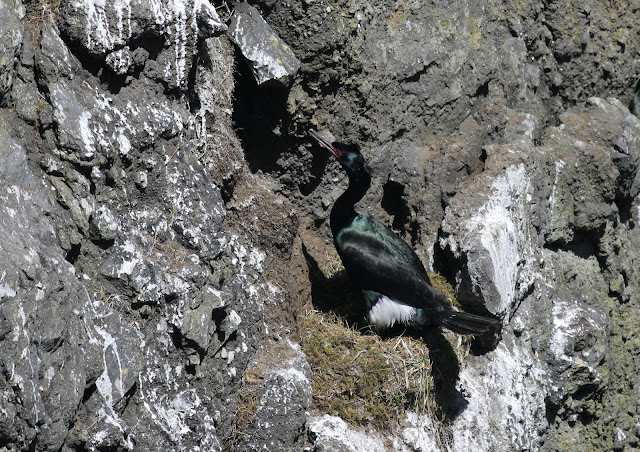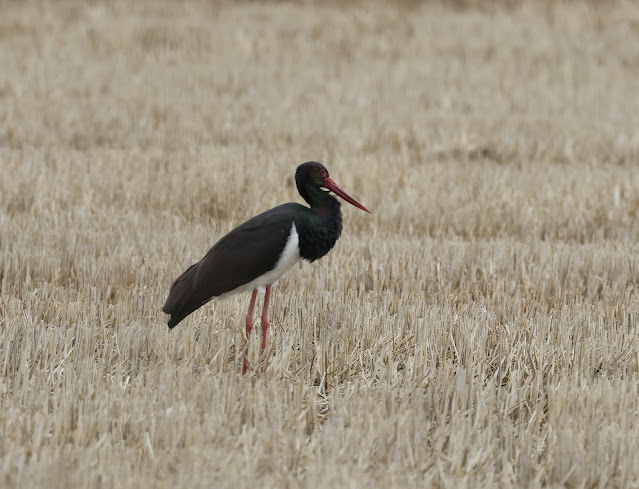Although the European Shag is mostly found in Europe, it can also be found in North Africa and Iceland as well. It is the only cormorant in its genus and was found to have diverged from other cormorants over 9 million years ago. I have seen them in a couple places but only obtained decent photos in my last trip to the south of France. These pics are from Cap d'Antibes. Although they look similar to Double-crested Cormorant, in most of their range they don't overlap. The Great Cormorant is the other one that overlaps but they can easily be separated.
Sunday, June 29, 2025
Pelagic Cormorant (Urile pelagicus) - 31May2021
The Pelagic Cormorant is one of 4 species in the Urile genus which all inhabit the northern Pacific Ocean. The others are Brandt's, Red-faced and the extinct Spectacled Cormorant. The Pelagic Cormorant is normally found on the ocean, but during breeding season they build nests in seaside cliffs and can easily be seen there. I saw my first ones in San Diego, but I got much better looks when in Oregon where they were nesting on cliffs at the Yaquina Head Lighthouse.

Saturday, June 28, 2025
Masked Booby (Sula dactylatra) - 27Aug2023
Masked Booby is one of the six birds in the genus Sula. Here in North Carolina we have semi-annual sightings usually in the Gulf Stream off Hatteras.
Jabiru (Jabiru mycteria) - 17Aug2022
The Jabiru is a truly awesome bird to see, standing up to 5 feet high with a wingspan of 9 feet across. We saw tons of them in the Pantanal. They are the tallest flying bird in the Americas, and have the second largest wingspan after Andean Condor (not including Wandering Albatross which is oceanic).
Friday, June 27, 2025
White Stork (Ciconia ciconia) - 10Feb2025
The White Stork has a wide distribution and importance all over Eurasia and Africa. The storks are known to predate on rats and other vermin which made them important to people who associated the vermin with disease. Old European folklore about storks carrying babies to expecting parents was ancient but popularized with the fables of Hans Christian Andersen in the 19th century. White Storks frequently nest on roof tops or church belfries which makes them easy to spot. I saw mine in agriculture fields in the Carmargue in the south of France.
Maguari Stork (Ciconia maguari) - 22Aug2022
The Maguari Stork is the new world equivalent of the White Stork of Eurasia. They are massive birds which eat pretty much anything and everything around including small mammals. We saw ours in the Pantanal in Brazil. They have a pretty wide distribution in South America on either side of the Amazon basin.
Thursday, June 26, 2025
Black Stork (Ciconia nigra) - 10Feb2025
Black Storks range all over Eurasia and Africa but that doesn't take away how cool these huge birds are. It seems they are more wary of humans than the other stork in Europe (White Stork). This one was photographed in the Camargue in southern France.
Yelkouan Shearwater (Puffinus yelkouan) - 11Feb2025
Scopoli's Shearwater (Calonectris diomedea) - 11Jun, 22&27Aug2022
Scopoli's Shearwater is the result of a recent split from Cory's Shearwater. Both are present in the North Carolina Gulf Stream, with numbers fluctuating depending on breeding and molting schedules. The Scopoli's Shearwater has some subtle differences with maybe some of the birds are best left unidentified. The main field mark is amount of white extending into the bird's "hands" which are just the outermost primary feathers including P9 and P10.
Wednesday, June 25, 2025
White-chinned Petrel (Procellaria aequinoctialis) - 26Feb2022
The White-chinned Petrel is a large petrel of the southern oceans which ranges quite far north to Peru in South American waters and Namibia in African waters. We saw many riding the wind currents in the Drake Passage across to Antarctica. The white chin is very subtle but you can see it if you click on the image and zoom in.

Slender-billed Prion (Pachyptila belcheri) - 20Feb2022
This is the second and very similar Prion species that we saw on our voyage across the Drake Passage to Antarctica. As you can gather from the name, the best field mark to tell these apart from the Antarctic Prion is the shape and length of the bill which is more slender on this one. There are other subtle field marks that add up to give this one a different overall impression. For example, the M shape on the back is less pronounced and the white supercilia (eyebrow) is wider and consequently gives it less of a black mask.
Antarctic Prion (Pachyptila desolata) - 20Feb2022
Bermuda Petrel (Pterodroma cahow) - 18May2024
This was my nemesis bird until 2024 and a good one at that. In North Carolina we can go a whole year without seeing one on Hatteras pelagic trips out to the gulf stream. In 2024 they had a couple and I was lucky enough to see one. Some info from Wiki about Bermuda Petrels:
"For 300 years, it was thought to be extinct. The dramatic rediscovery in 1951 of eighteen nesting pairs made this a "Lazarus species", that is, a species found to be alive after having been considered extinct. Its rediscovery inspired a book and two documentary films. A national programme to preserve the bird and restore the species has helped increase its numbers, but scientists are still working to enlarge its nesting habitat on the restored Nonsuch Island."
Tuesday, June 24, 2025
Soft-plumaged Petrel (Pterodroma mollis) - 26Feb2022
This petrel of the southern oceans is similar in plumage to Fea's, Desertas and Zino's Petrels further to the north and at one point they were all in the same genus in some taxonomies. We only had them in the crossing to Antarctica and they were super quick and did not stay close to the boat. I snapped a hundred photos at a distance and only came away with these sub-par shots.
Pintado Petrel (Daption capense) - 20&23Feb2022
Pintado Petrels, otherwise known as Cape Petrels, range all over the Southern Oceans and we had them in several places including while crossing the Drake Passage.
Here are some interesting factoids from Wiki:
The genus name Daption is an anagram of the Portuguese name "Pintado" which was given to the species by navigators because of its pied plumage. Pintado is Portuguese and Spanish for "painted". The specific epithet capense signifies the Cape of Good Hope, the locality where the type specimen was collected. The word petrel is derived from Saint Peter and the story of his walking on water. This is in reference to the petrel's habit of appearing to run on the water to take off. Historically, it was also sometimes known as "Cape pigeon", due to early sailors thinking it resembled a pigeon."
Southern Fulmar (Fulmarus glacialoides) - 20Feb2022
The Southern Fulmar shared the Fulmarus genus with its Northern cousin but inhabits the southern oceans instead. They also can have many different color morphs. We had several of them during the Drake crossing on the way to Antarctica.
To me they look like avian dolphins and they playfully fly above the waves like dolphins can below the waves.
Northern Giant Petrel (Macronectes halli) - 18&22Feb2022
Previously considered a sub-species within the same genus as Southern Giant Petrel, they were split out in the 1960s. The Northern has a red-nosed bill while the Southern has green. The Northern also has a dark and light morph as you can see from my pics below. We saw these all over the Beagle Channel, across the Drake and in Antarctica. They have a devious and smart look to them.
Some of them looked kind of goofy and Gonzo-like with the bulbous red-tipped nose.
Southern Giant Petrel (Macronectes giganteus) - 19&25Feb2022
The Giant Petrels in Antarctic and Patagonian waters are truly huge and nasty, earning the nickname Stinkpot or Stinker. The Southern is differentiated from the Northern by the green tip of the bill which is reddish in the Northern. When threatened they can spray stomach juices out of their mouths. They come in dark and light morphs like the ones I photographed below on my trip to Antarctica. They mostly scavenge and I saw them feasting on the carcasses of penguins that Leopard Seals killed but they can also hunt and kill various things including other seabirds. They have been seen ganging up on and drowning Albatrosses.

We were able to see some of the big fluffy white chicks on some of the Antarctic islands we visited.
Sunday, June 22, 2025
Black-bellied Storm Petrel (Fregetta tropica) - 20Feb2022
The Black-bellied Storm Petrel is a tiny dancer on the rough seas of the southern oceans. This one was seen in the infamous Drake Passage on the way to Antarctica. I thought it strange that the second half of the latin binomial is tropica given where I saw it, so I looked it up. They apparently do migrate to tropical waters in the summer (northern summer).
Wednesday, June 18, 2025
Black-browed Albatross (Thalassarche melanophris) - 20&27Feb2022
Although this was the most consistently seen species on our Antarctica trip with hundreds of them visible at some points, they still made my jaw drop up until the last day of the trip. Like all Albatrosses, they are amazing to watch as they glide effortlessly over the southern oceans. We have had a few records of them up in North Carolina but I haven't seen one yet. Hoping this is the year!















































